Every now and then, a museum acquisition is worth highlighting because either the work is, to me, fanatastic, or because it makes another point.
The other day, the Museum of Fine Arts, Houston, announced that it had acquired a dozen light-based works by James Turrell. Turrell has many fans.  Now, I have not seen the Roden Crater, but his light works haven’t always thrilled me. When I recently visited the MFAH, I was underwhelmed by the work that runs underground in a tunnel linking the museum´s two buildings. It´s called ¨The Light Inside.¨ (It´s pictured here.) On the other hand, I do like his skyscapes.
Now, I have not seen the Roden Crater, but his light works haven’t always thrilled me. When I recently visited the MFAH, I was underwhelmed by the work that runs underground in a tunnel linking the museum´s two buildings. It´s called ¨The Light Inside.¨ (It´s pictured here.) On the other hand, I do like his skyscapes.
And, since many do think Turrell is an excellent artist who will stand the test of time, the acquisition is notable on the second score: MFAH has had a ¨longstanding commitment¨to Turell´s work, and this builds on that strength. It could well be one of the museum´s points of differentiation, at a time when too many museums are building too-similar collections.
The purchase, using funds from an acquisitions endowment, continues a partnership that dates to the 1994, and it evolved from conversations Turrell had with the late Peter Marzio, who directed MFAH for nearly 30 years until his death last December. Â
Turrell, the museum says, titled the group of works aquired by MFAH “Vertical Vintage” — because it is a retrospective selection that reflects the full arc of his engagement with artificial light. Dates on the works begin in 1967 and continus to his most recent “Tall Glass” series, dated 2010.
Read more in the press release here, including the list of works.
As MFAH notes, just this month, Turrell was elected to The American Academy of Arts and Letters, and later this year, his work will be shown at the Venice Biennale.
Swiss collector Donald Hess has built a museum for Turrell´s work, but it´s in northwest Argentina. The flight from Argentina takes more than two hours, according to the Wall Street Journal. Not every Turrell fan will be able to go there. If MHFA is a place his fans turn instead, MFAH´s purchase will have been worth it. Of course, we don´t know that price…it wasn´t disclosed.
Photo Credit: Courtesy of MFAH
Â





